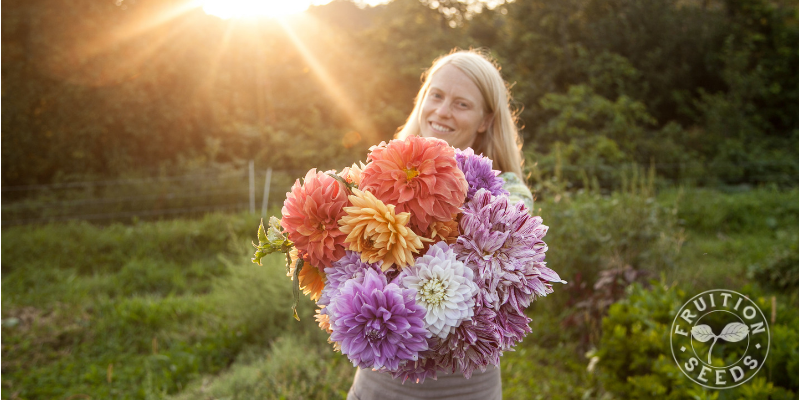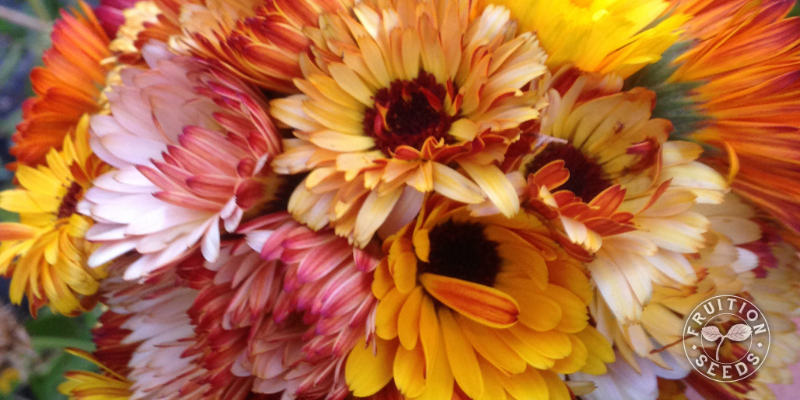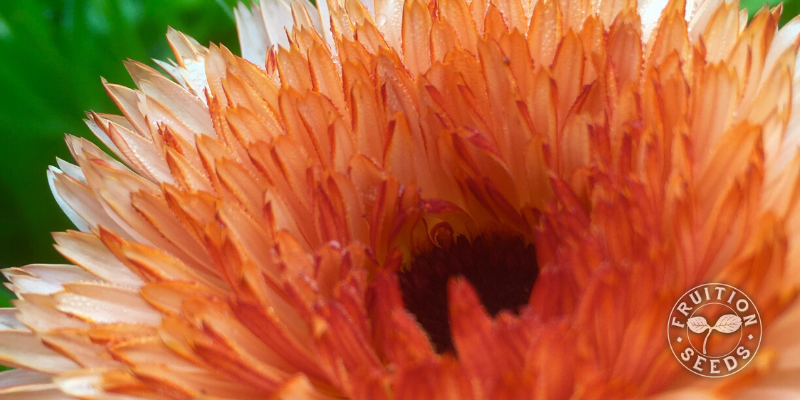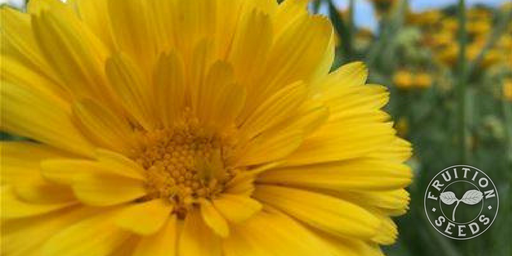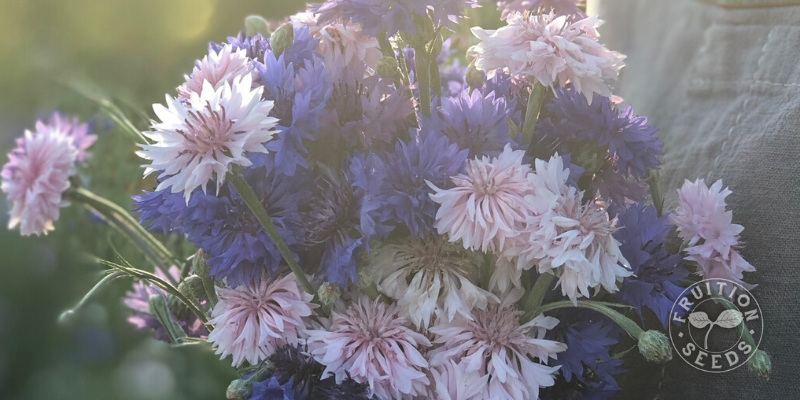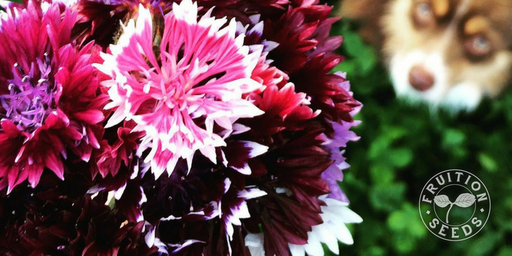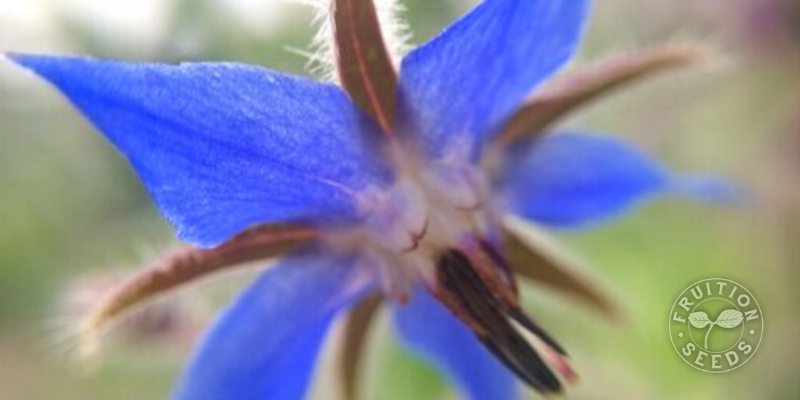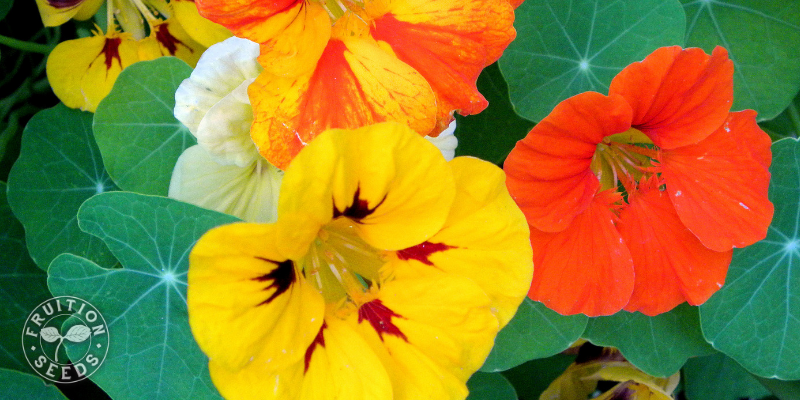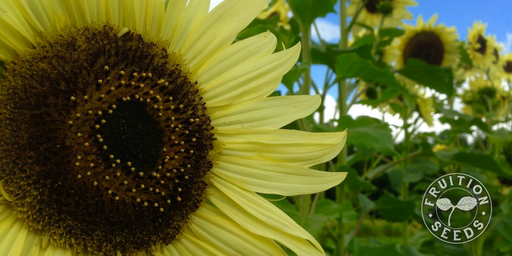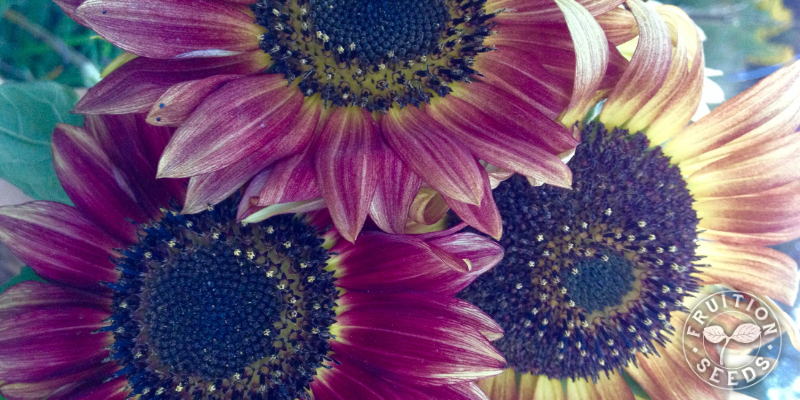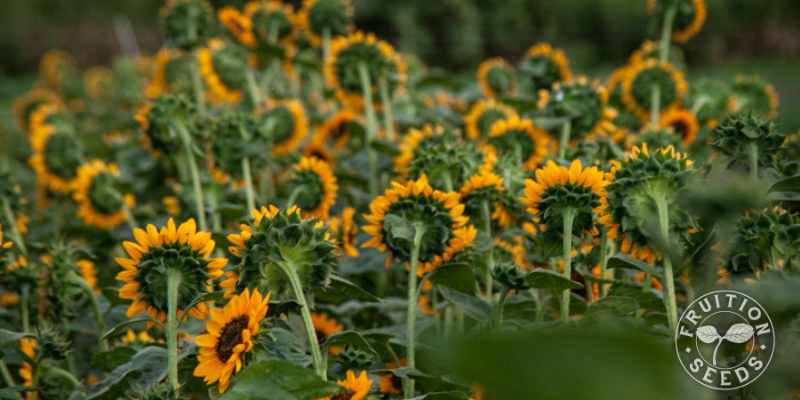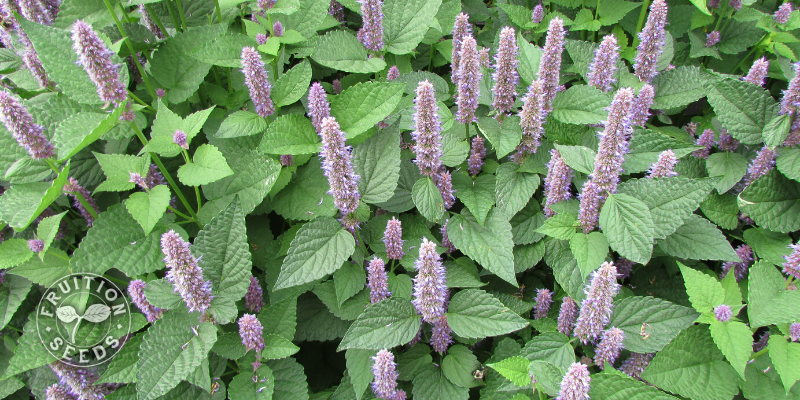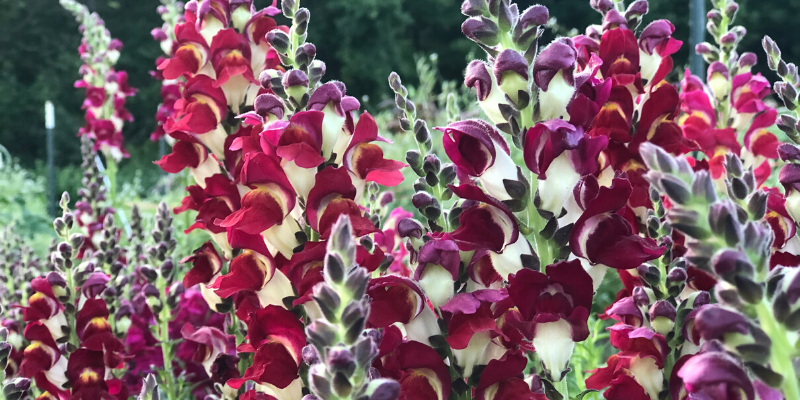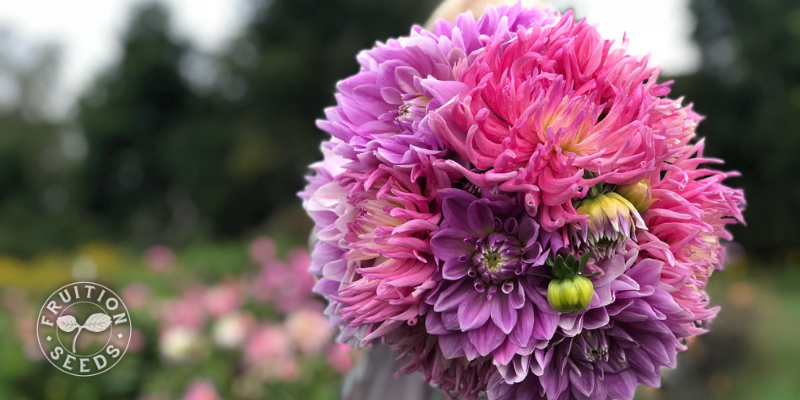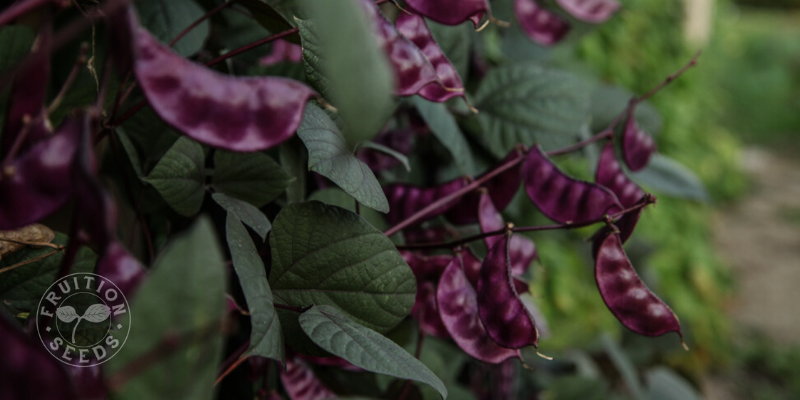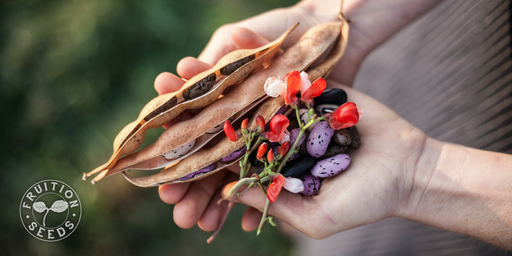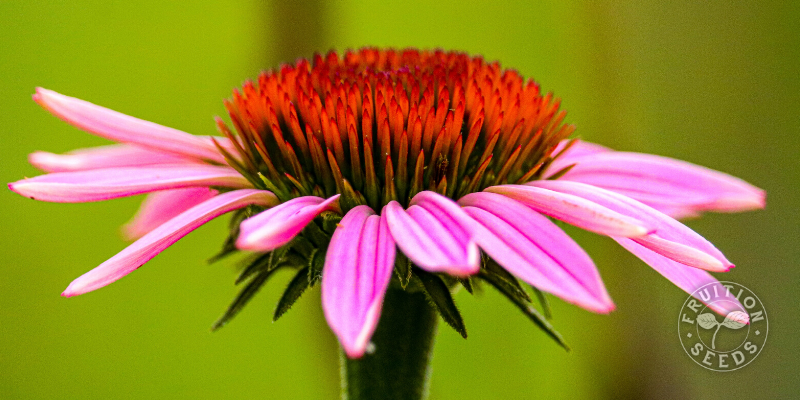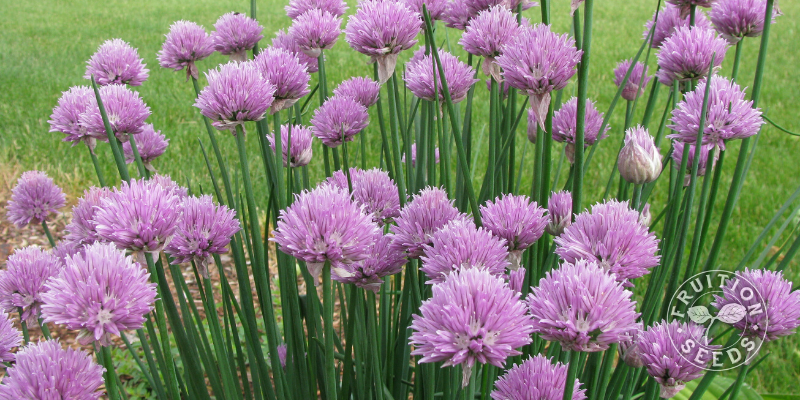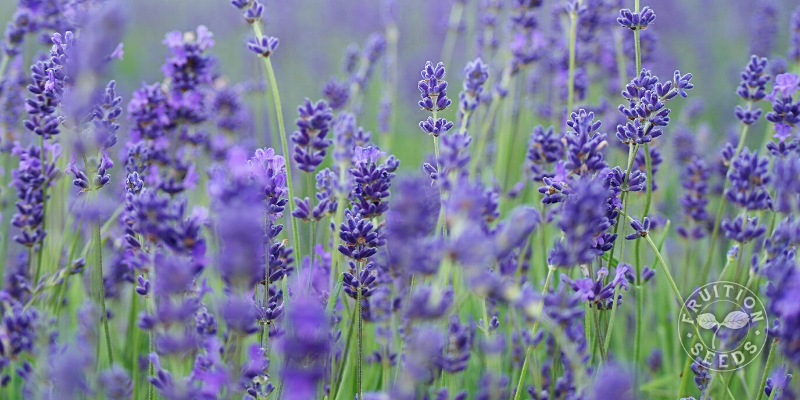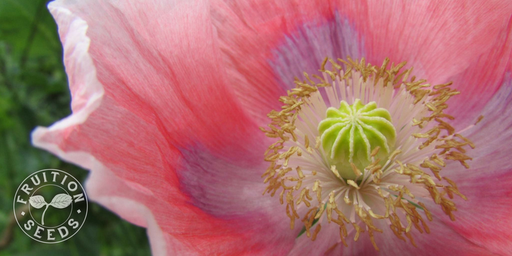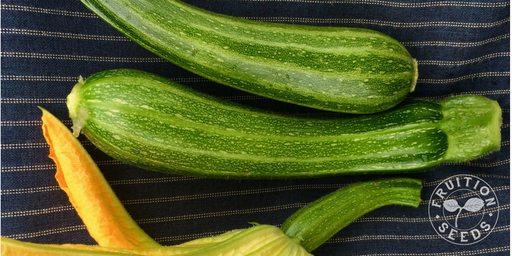Edible flowers are the best of all worlds, feeding us in so many ways beyond beauty, beyond calories, growing our ability to see beyond what we’ve known before.
As we seed our vegetables for the season ahead, now more than ever we sow the seeds of these edible flowers with a vast appreciation for their power to transform, with love, the world around them.
We are what we eat, so let’s make it beautiful!
You’ll find our full collection of edible flowers here and in the meantime, here are our favorites:
Calendula
Easy to grow in any soil, any container and even limited sun, calendula is beautiful, edible and medicinal. Pluck the petals from the center calyx to toss in salad and strew across cakes! They have a mild marigold scent and flavor, which is heavenly.
Just over one foot wide and tall with a rainbow of colors, calendula is also a favorite of pollinators and is easy to save the seed of, in fact re-seeding herself if you don’t harvest all her flowers and seeds, first.
The more you harvest your calendula, the more she’ll blossom. Undaunted by cold, we’ve had calendula blossoming here on our farm in Zone 6 til December!
https://www.fruitionseeds.com/shop/herbs/organic-remembrance-edible-calendula-mix/We’re especially proud of our Remembrance Mix, which we selected in collaboration with Remembrance Farm just outside Ithaca, to bring more beauty and abundance to their signature edible flower salad mixes:
We’re also endlessly fond of Zeolights, an exquisite selection of Frank Morton of Wild Garden Seed in Oregon:
All calendula is both edible and medicinal, but if you’re wanting to make the most potent healing salves, grow Resina. Named for her medicinal resins so abundant her flowers and stems are sticky, she’s not as lovely to eat, but your skin will know all the difference.
Calendula Planting Keys:
~ direct sow after snowmelt or start indoors anytime after snowmelt to harden off and transplant once 1 to 2 sets of true leaves have emerged
~ direct seed or transplant as you prefer
~ sow with one foot between plants
~ full sun / partial shade
~ 16″ tall
~ readily self-sowing annual
~ easy to save seed
~ thrives in containers
Bachelor Button
Bachelor Button, also called Corn Flower (for their prevalence in eastern European grain fields, where they are native), is also easy to grow. Three to four feet high, Bachelor Buttons petals are light, vibrant confetti with virtually no distinct flavor, fully beautifying everything around them. They also thrive in poor soil and drought, so they are better than most for container gardens. The more you harvest the more they’ll blossom! And they’re covered in pollinators, from butterflies to native bees, from mid-summer through frost.
Polka Dots is our classic mix:
And Burgundy Beauties is my favorite! We’ve been selecting it for years and her spectrum of mauve, raspberry, rose and lavender is sincerely extraordinary:
Bachelor Button Planting Keys:
~ sow indoors ~4 weeks before final frost, transplant after final frost
~ transplanting is optimal
~ transplant with one foot between plants
~ full sun
~ 3 to 4 feet tall
~ readily self-sowing annual
~ easy to save seed
~ thrives in large (5+ gallon) containers
Borage
Also easy to grow in any soil, any container and even limited sun, borage shares edible star-shaped blossoms as well as young leaves, both with a hint of cucumber. Eighty percent of her blooms are deep azure blue and the balance are shell pink. The abundance of bees, butterflies and native pollinators attracted to borage don’t seem to have a preference and neither do we!
Borage is often three feet tall, more or less as the fertility beneath her dictates. Once her seed matures she quickly drops it, so harvesting seed is not the easiest though she does gently re-seed in your garden. Her large (delectable!) first leaves in early spring are easy to identify and transplant as you wish.
Borage begins to blossom in early July and doesn’t stop til frost.
Borage Planting Keys:
~ direct sow after snowmelt or start indoors anytime after snowmelt to harden off and transplant once 1 to 2 sets of true leaves have emerged
~ transplant with 1.5 feet between plants
~ full sun
~ 3 feet tall
~ gently self-sowing annual
~ thrives in large (5+ gallon) containers
Nasturtium
Nasturtium (or Nasties, as my Brit friends call them!) are also impressively easy to grow with very little care, fertility, water and even sun, though the more sun they receive, the more they will blossom. Both young foliage and flowers have a bright pepper flavor and distinct succulence that we love on salads as well as seared green beans, blended into aioli and, well, everywhere. We also pickle their young green seed pods for our favorite homegrown capers.
Nasturtiums, left to their own devices, will vine 6+ feet, so we grow them in hanging baskets as well as above fences and also in large wine barrels so they can parade at will without carpeting everything else around them.
Nasturtium Planting Keys:
~ direct sow after frost or sow indoors ~4 weeks before final frost, transplant after final frost
~ direct sow or transplant as you wish
~ transplant with one foot between plants
~ full sun for best flower production
~ 1 foot tall and 6+ feet long
~ annual
~ thrives in large (5+ gallon) containers
Sunflower
It was only a few years back that I learned sunflowers are edible! And Friends, I’ve never looked back. All sunflower petals are edible, across their myriad colors, shapes and sizes, and try them all! You’ll find subtle differences but I suspect you’ll be tossing them on all your salads this summer, just like us. We find the more light yellow and small the petals are, the more delicious they are: Larger petals and darker colors tend to be more bitter and less tender.
Teddy Bear and Bee-Loved (below) are the most delectable of all the sunflowers we share:
Sunflowers are easy to grow in any soil and even the dwarf varieties thrive in containers. If you want taller plants with more flowers, add more balanced, organic fertility that isn’t too nitrogen-rich. Dwarf varieties like Sonja and Soraya are easiest to harvest and also produce 20+ long, strong secondary blooms, meaning that many more petals for you to savor.
Our Lemon Queen is especially tall, easily 10+ feet in rich soil, and covered in butterflies and bees from mid-July through September:
Evening Colors is a gorgeous rainbow of autumnal hues, exceptionally tall and hummingbirds visit her blossoms, as well:
Dwarf sunflowers like Sonja (3′) and Soraya (4-5′) are ideal for growing cut flowers as well as abundant petals to harvest:
Sunflower Planting Keys:
~ direct sow after last frost, sunflowers prefer not to be transplanted
~ plant with (at least!) one foot between plants
~ full sun
~ height varies 3 to 15 feet by variety
~ annual
~ easy to save seed (see our blog for the full story!)
~ thrives in large (5+ gallon) containers
Anise Hyssop
Everything about Anise Hyssop is delectable as well as medicinal. Once established, she rises in early spring along with the daffodils, her fragrant anise leaves delicious in tea and her flowers delicious in everything!
Anise hyssop is a hardy perennial thriving in any soil, even in containers and limited sun, her 3′ tall blossoms attract oceans of pollinators from mid-summer to frost.
Also, the most exquisite shortbread I’ve ever eaten had the seeds of anise hyssop baked in
Anise Hyssop Planting Keys:
~ sow indoors ~4 weeks before final frost, transplant after final frost
~ transplanting is optimal
~ transplant with one foot between plants
~ full sun
~ 3 feet tall
~ perennial
~ easy to save seed
~ thrives in large (5+ gallon) containers
Snapdragon
Though I’ve loved snapdragons since before I could fully arrange sentences (!), I was 35 years old when I finally learned they are edible. Across their wide spectrum of colors, shapes and sizes, some varieties are sweeter than others but tossed in a salad, I’ve found I have no experience other than joy
Snapdragons are reasonably easy to start from seed and once established they grow fabulously in most soils as well as large containers, their 2-3′ spires blossoming constantly from mid-July through September.
Snapdragon Planting Keys:
~ sow indoors ~4 weeks before final frost, barely covering seed; transplant after final frost
~ transplanting is optimal
~ transplant with one foot between plants
~ full sun
~ 3 feet tall
~ annual
~ thrives in large (5+ gallon) containers
Dahlias
Yes, dahlias were domesticated in montane Mexico as a food crop! Both their tubers and petals are edible (so much more to share!) and the two varieties we’ve found that are genuinely delectable are Fern Cliff, like floral butterhead lettuce, and Star’s Favorite, like floral, grassy asparagus.
We make the most outrageous salads of just their petals all August & September!
Dahlias thrive in full sun and range from 1 to 5 feet tall. Fern Cliff and Start’s Favorite are full-size, easily growing 4+ feet tall. We love to stake ours with horizontal trellising to help them stay upright and promote airflow to diminish powdery mildew.
Dahlia Planting Keys:
~ direct sow tubers horizontally in soil after final frost or sow indoors ~4 weeks before final frost, not watering until sprouts emerge; transplant after final frost
~ transplanting is optimal
~ transplant with two feet between plants for full-size varieties like Fern Cliff and Star’s Favorite
~ full sun
~ 1 to 5 feet tall, depending on variety
~ annual
~ dig tubers in fall to save for next season
~ thrives in large (5+ gallon) containers
Hyacinth Bean
We first saw hyacinth bean climbing 20+ feet in the gorgeous gardens of Roger Swain, the host of PBS’ Victory Garden series. He kindly returned our jaws to our faces and harvested us a handful of seed, which is the foundation of every seed we now share today
The hyacinth beans themselves are not edible, but their orchid-like lilac flowers are soft, sweet and utterly delectable. Hummingbirds often next in ours and it’s hard to eat every single flower, since they are so prolific, so you’ll still be able to enjoy their luminescent pods and save plenty of seeds for next season.
Hyacinth Bean Planting Keys:
~ direct sow after final frost
~ thin to one foot between plants
~ full sun
~ they’ll grow as tall as your trellis, from 4 to 24 feet! (We trellis ours with this.)
~ annual
~ easy to save seed
Chocolate Runner Bean
Similar to hyacinth bean, the green pods of chocolate runner beans are fibrous and unappetizing. Their flowers, by contrast, add color and just a touch of sweet to salads. Hummingbirds lose their minds in the wall of crimson and cream, and if you miss a few flowers (and you will, there are so many!), let the green pods mature to gold and harvest the extraordinary beans in fall. They’re delicious, like massive cannellini beans, just save a few to sow again next season and share with your friends
Chocolate Runner Bean Planting Keys:
~ direct sow after final frost
~ thin to one foot between plants
~ full sun
~ they’ll grow as tall as your trellis, from 4 to 24 feet! (We trellis ours with this.)
~ annual
~ easy to save seed
Echinacea
Best known for her medicinal qualities, echinacea’s vivid petals are also edible! Just be sure to pluck them off the center of the flower, which is surprisingly spiky.
Echinacea Planting Keys:
~ sow ~4 to 6 weeks before final frost, transplant after final frost
~ transplanting is optimal
~ transplant with one foot between plants
~ full sun
~ 3 to 4 feet tall
~ perennial
~ easy to save seed
~ thrives in large (5+ gallon) containers
Chives
Almost absurdly easy to grow, chives are impressively perennial and their flowers in June are in fact dozens of flowers, each one rich with chive flavor. We love sear whole flowers to toss on stir-fries; we also break apart the flowers to enjoy on salads and garnish soups. Blend them into your aioli, tuck them into your sandwiches!
Chives concentrate their blooms in June here in Zone 5, all within a few weeks of each other, so enjoy them while you can!
Planting Keys for Chives:
~ sow ~4 weeks before final frost, transplant after final frost
~ transplanting is optimal
~ transplant with one foot between plants
~ full sun
~ 12 to 16 inches tall
~ perennial
~ easy to save seed
~ thrives in 3+ gallon containers
Lavender
Lavender is edible, medicinal and endlessly beautiful as well as resilient once established, though establishing her can be a trick. A classic Mediterranean plant, lavender loves well-drained soil and not too much fertility, plenty of sun and mulch in winter when you live in Zone 5.
Harvest her flowers at peak and enjoy fresh or dry.
Lavender Planting Keys:
~ sow ~4 weeks before final frost, transplant after final frost
~ transplanting is optimal
~ transplant with one foot between plants
~ full sun
~ 3 to 4 feet tall
~ readily self-sowing annual
~ easy to save seed
~ thrives in large (5+ gallon) containers
Chamomile
Though we never toss chamomile in salads, I would be remiss to share edible flowers I love without adding her!
Chamomile is such an etheric plant, easily producing hundreds of deliciously medicinal blossoms from late June through frost, if you’re harvesting flowers consistently.
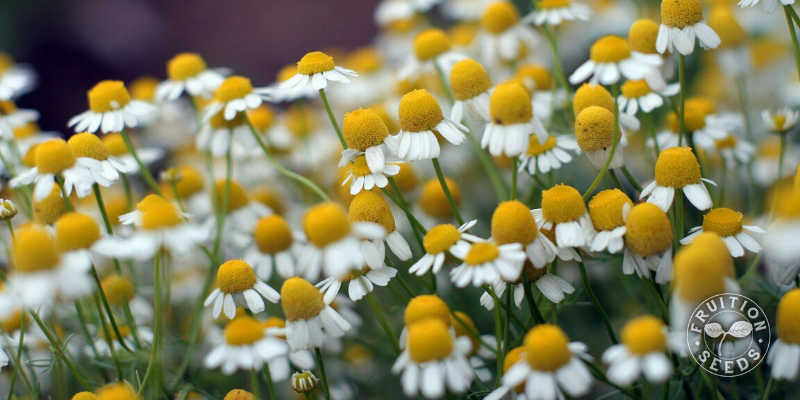
Chamomile Planting Keys:
~ sow ~4 weeks before final frost, transplant after final frost
~ transplanting is optimal
~ transplant with one foot between plants
~ full sun
~ 3 feet tall
~ readily self-sowing annual
~ easy to save seed
~ thrives in large (5+ gallon) containers
Basil, Dill, Arugula, Broccoli, Fennel & More!
I also would do the world a grave disservice to not mention the flowers of so many other plants, not traditionally grown as edible flowers (or even flowers at all!) that we love to enjoy the flowers of. Any flowering brassica has delicious flowers and many herbs also have delicious flowers. Explore, experiment and enjoy the adventure!
This is Thai Basil, by the way, as ornamental as she is delectable:
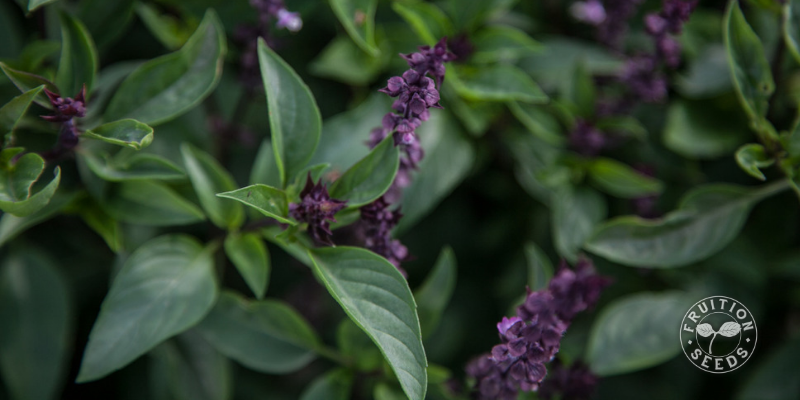
Poppy
Finally, though we don’t eat the petals, we love to eat the abundant seeds of poppies! Will Bonsall shared his selection of Ziar’s Breadseed poppy with us in Maine and it continues to join us all over our farm and all over our kitchen, as well
Poppy Planting Keys:
~ poppies love to establish in cool soils
~ sow ~8 weeks before final frost; harden off & transplant ~ 4 weeks before final frost
~ transplanting is optimal
~ transplant with one foot between plants
~ full sun
~ 2 to 3feet tall
~ gently self-sowing annual
~ easy to save seed
~ thrives in large (5+ gallon) containers
~ harvest the seeds once their green pods turn gold
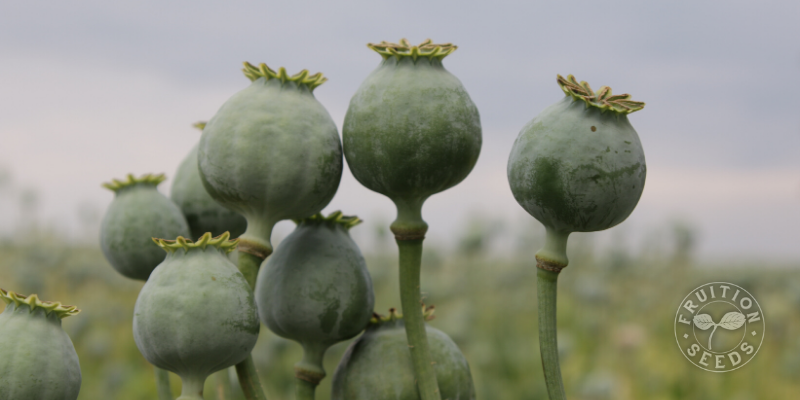
Squash Blossoms
Last but not least, we love to eat squash blossoms!
Since squash like zucchini have both male and female blossoms, be sure you’re only eating male flowers so you’re not sacrificing the fruit itself. (They’re easy to tell apart: The female ovary is a tiny zucchini, butternut or whatever other squash you’re growing. The male flower is simply on a narrow stalk!)
Zucchini Planting Keys:
~ direct sow after final frost
~ sow/thin leaving two feet between plants
~ full sun
~ 3 feet tall & wide
~ readily self-sowing annual
~ thrives in large (15+ gallon) containers with *lots* of fertility
Enjoying edible flowers all summer long is one of the simplest, sweetest ways we bring joy to our lives! May beauty and abundance surround you this season, as well as a sense of adventure.
We are what we eat, so let’s make it beautiful!
Sow Seeds & Sing Songs,

and the Many Beings of Fruition
